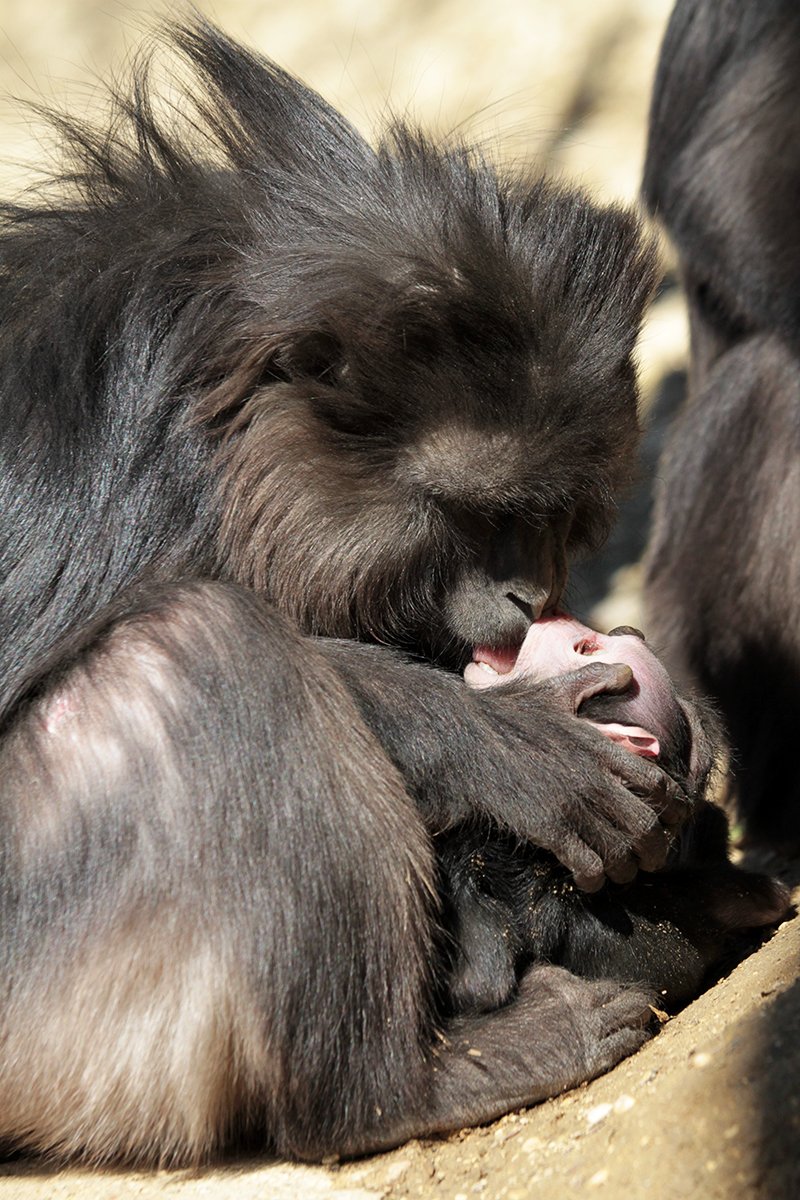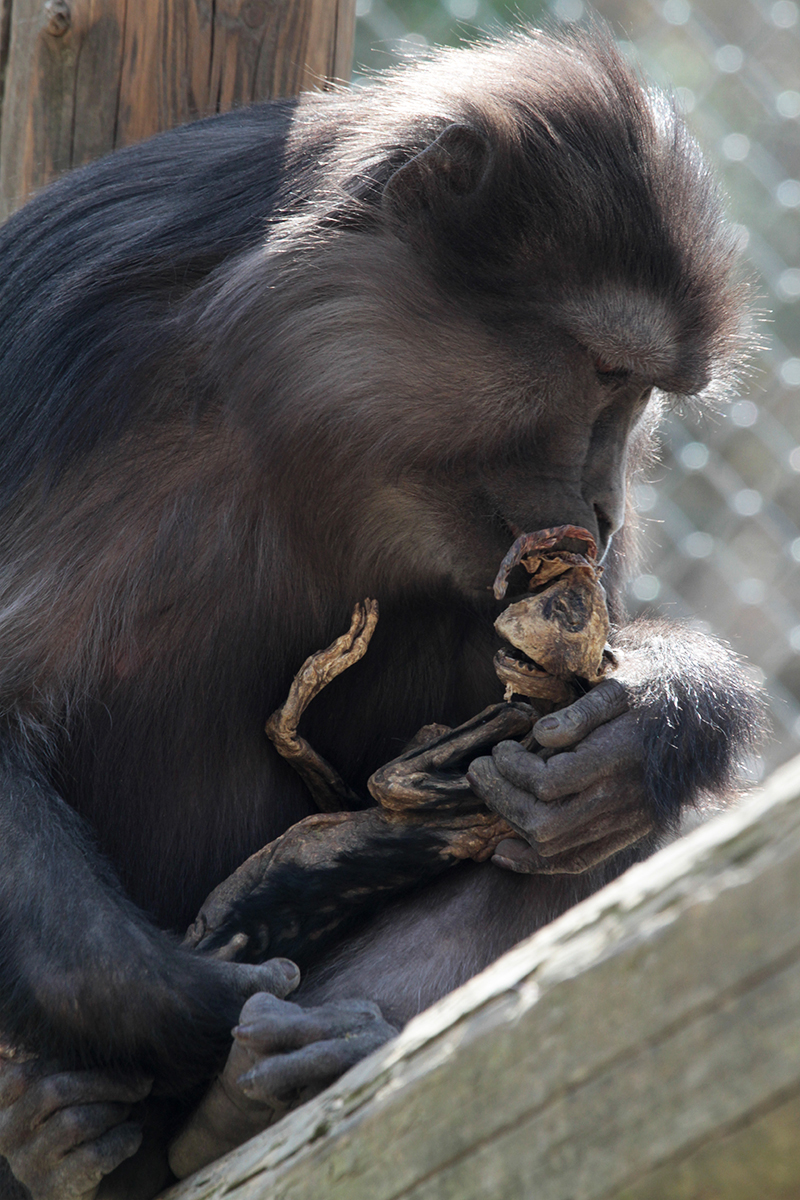Mourning Mom? Macaque Carries Daughter's Mummified Corpse for 4 Weeks

Loss and grief can make people do strange things, but that's nothing compared to our cousins in the animal kingdom. Recently, in a wildlife park in Italy, one macaque mother named Evalyne whose newborn died after just five days spent four weeks carrying around the infant's mummified remains.
In addition to occasionally grooming the decaying body, Evalyne was also seen taking bites of her deceased daughter, cannibalizing the remains in what may have been a final maternal instinct, the researchers studying her said in a case study published online Sept. 20 in the journal Primates.
"Everybody asks us why the mother came to cannibalize her offspring. To be honest, we simply do not know," said study co-author Bernard Thierry, a research director at France's National Center for Scientific Research, who studies ecology and physiology. [See Photos of Evalyne Caring for the Corpse of Her Infant Macaque]
Grief or delusion?
"Maternal care of infant corpses is the most frequently documented response to death by monkeys and apes in both natural and captive settings," the researchers wrote in the journal article. The main difference, explained Thierry, is that most macaques, including those whose offspring were stillborn or died shortly after birth, would have stopped tending to the corpse sooner.
Regardless, questions remain as to why a mother would continue caring for a lifeless body — for instance, is she actually grieving or does she mistakenly think her baby is alive?
This newly described case, the researchers say, could help to shed light on this question and others linked to this seeming maternal behavior.
Mummified baby
In the first few days of her newborn's death at Parco Faunistico di Piano dell'Abatino in Italy, Evalyne, a Tonkean macaque, would skip meals and throw tantrums, occasionally screaming at her own reflection, the researchers wrote. She was inseparable from the body of her daughter and groomed it, even sometimes sticking her finger or tongue into the body's mouth — something that macaques will do to get their newborns to start suckling. [8 Human-Like Behaviors of Primates]
Sign up for the Live Science daily newsletter now
Get the world’s most fascinating discoveries delivered straight to your inbox.

Evalyne's daughter was fully mummified eight days after she died. It was a cold, dry winter, so the body didn't decompose as it might normally have, and instead became desiccated. As such, to Evalyne, the remains would have looked like a newborn macaque for a longer period, the researchers said. In the research, Thierry suggested that this lifelike appearance may have prolonged Evalyne's maternal instincts toward the body.
"In the future, we should devise experiments aiming to know whether animals are able to discriminate between dead and alive, or inanimate and animate bodies," Thierry told Live Science.
In the following weeks, the corpse of Evalyne's daughter continued to decompose. But even as the skin and fur fell away from the mummified corpse, Evalyne continued to groom and tend to it. Evalyne kept the body with her at all times, either carrying it in one hand against her chest or in her mouth, according to the journal article. Thierry mentioned that this isn't terribly atypical for macaque mothers — many of whom will tend to a child's corpse for some time after death, if not for as long as Evalyne did.
If Evalyne might have thought that her daughter was still living, the lack of a response to being carried in her mouth ought to have given it away. "By contrast," Thierry added, "an alive infant would protest, reminding the mother to be more careful."
It was not until three weeks after her daughter died that Evalyne finally let go — physically — for the first time. According to the research, it was not until the 18th day that Evalyne first briefly put what was left of the remains, a fragmented skeleton with some mummified flesh hanging on, on the ground. Another female macaque went over to investigate, and the two wrestled playfully.
"In the first two weeks, Evalyne would have protested and defended the corpse," Thierry said. "But in the third week, the body started breaking apart and the mother was likely in the process of slowly detaching from it."
The next day, Evalyne took a bite out of her daughter's corpse. Over the next week, she would occasionally gnaw on the bones and eat small pieces of mummified remains. When the body inevitably decayed into multiple pieces, Evalyne held one of them in her mouth at all times until there was no sign of the daughter's body.
Evalyne may have held onto her deceased child for so long out of maternal instincts, and the four days that the child lived could have been long enough to form an attachment that elongated the process of letting go, the research suggests. But another school of thought addressed in the paper argues that macaques may not understand death and that the deceased infant's preserved state may have been confusing to Evalyne.
As for why the human observers never intervened while watching this behavior play out: "Our rule as professionals studying animal behavior is not to intervene as long as there is no harm for individuals," Thierry said. "As human beings, however, we may be moved by what we see, of course. In the case of Evalyne, the best was to stay out. Removing the corpse would have been psychologically traumatic for her. Letting her progressively detach from the body was probably the best solution."
Original Article on Live Science.










